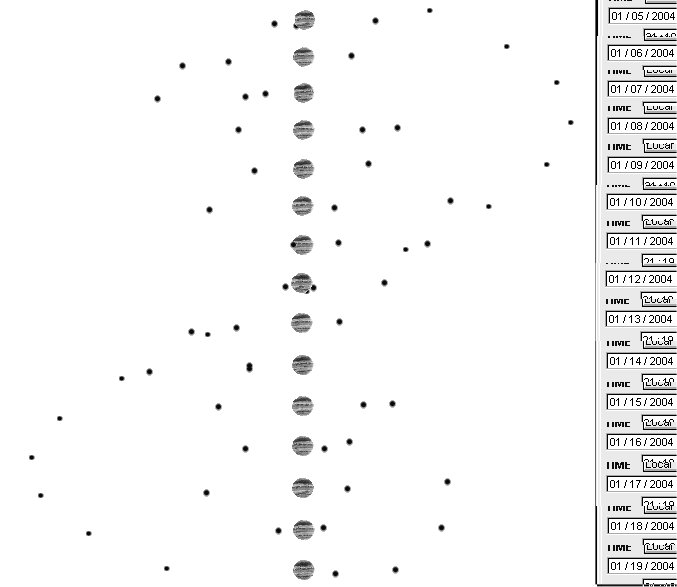Disclaimer: links to web sites are ever-changing. It
turns out to be a Sisyphus task to keep them updated all the time.
Therefore, either try a different "spelling" of the hyperlink, look for it
on google.com and/or let me know about an outdated link by writing an e-mail
to aveh@wncc.net .
Lab G1 Jupiter's
moons
Objective: Determine the orbits of the 4 large Galilean moons.
Procedure:
Go to
Paul Charbonneau's HAO page
. Pictures like this is what my students at the time and I saw through
the telescope every evening for two weeks in September 1998. We estimated
the distance of each moon to Jupiter, the result is the diagram below.
Please note that distances are estimations and that each student was
a rookie, so these drawings are not perfect!
Given this imperfection, I ask you for only two moons: Figure out
which one is Io and which one is Callisto. Try this by establishing
a pattern from one dayly record to the next and by paying attention to their
distances and periods (your textbook's appendix, Lab F9)
, i.e. Io can never be very far and orbits Jupiter quickly, Callisto can
be very far (but isn't all the time; see below) and
needs about 8 days from one far end to the other.

Jupiter's moons (September 1998). We're seeing their
orbits edge-on, so in the above diagram they're always (horizontally) lined
up with Jupiter. Two observations were "borrowed" from Redshift
because once I forgot and the other time it was cloudy in the evening and
when I woke up at 3 am I wasn't ambitious to get up.

Caution: compare this slightly tilted image to the 9-16 record above.
Notice that Callisto is appearing close to jupiter because it's almost
behind it. The point is that the above records are edge-on and therefore
a moon that appears close to Jupiter is not necessarily an inner moon.
(Note that sides are switched (the telescope reverses left
with right) and that whoever did the 9-16 record forgot Ganymede.)
Another hint: on the first two records (9-6/7) Io is just left of Jupiter.
Since Io takes 1.77 days to orbit, it's possible that appears in the
almost the same spot 24 hours later (once in front of Jupiter,
once behind; neither we can see because we're not seeing any depth, but we
can conclude so), i.e. it has completed about 2/3 of an orbit, not
a full one.

These observations were kind of interesting. The
upper one is from 9-10-1997. We were surprised to see only one moon:
apparently the other three were either in front of or behind Jupiter.
Sure enough, an hour later two moons appeared. The lower picture is
from 9-24-1995. I was surprised to see 5 "moons". I checked
Redshift and the fifth "moon" turned out to be Omega Ophiuchi
(the ecliptic runs through Ophiuchus North of Scorpius). The next night
Jupiter had moved quite some distance away from it.
While the above diagram with real observations is
used for identifying Jupiter's moons, the following diagram - manufactured
with Redshift - takes this a step further: due to its obvious accuracy,
Kepler 3 can be established by measuring periods and distances.

Lab G2 SUNSPOTS
, determine the ROTATIONal period of the Sun
Objective: Determine how fast sunspots "move" across our Sun's
surface. Since sunspots are actually stationary, this reveals the rotational
period of our Sun.
- What is the most important caution about observing our Sun?
- Obeying this caution, explain how you would observe our Sun.
- Compare the daily sunspot drawings and ESTIMATE, how long our
Sun needs for one rotation.



Images were taken at 12 noon on March 15, 19, and 20, 1998,
with an 8-inch Schmidt-Cassegrain f/10 at prime focus, 1/125 sec, using a
solar filter. Notice the sunspot group that is gradually "shifted"
from the middle to the bottom.
These images from the
Learmonth GONG
project in Australia are easier to evaluate.
The above photos are not the greatest yet. Instead of using
them, evaluate the most comprehensive set of drawings (projection
method; see the Mercury transit
) I have taken so far with my students. The drawings in the
table show our Sun's disk for 12 days in a row (September 1998), most of
them drawn at 12 noon (which was a convenient time just before lunch).
You'll notice soon that the equator runs from upper right to lower left (which
is also the direction the Sunspots "move"). Times other than noon
are in italics because here our Sun's equator is at a different angle.
S U N S P O T S

9-9, 12:00
Carol, Jack
|

9-10, 12:00
Carola
|

9-11, 12:00
Linda, Lorraine
|

9-12, 13:00
Andreas
|

9-13, 14:00
Andreas
|

9-14, 15:00 Mary,
Peggy, Theresa, Glenn
|

9-15, 12:00
Carol
|

9-16, 13:00
Andreas
|

9-17, 12:00
Andreas
|

9-18, 10:00
Spencer, Amy
|

9-19, 12:00
Andreas
|

9-20, 12:00
Andreas |
To my WNCC Astronomy home page
.


















